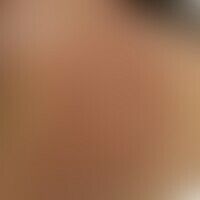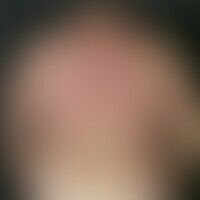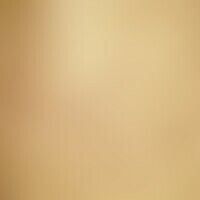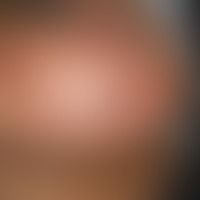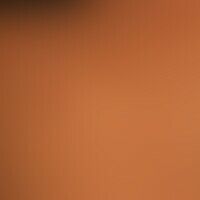Image diagnoses for "Torso"
563 results with 2198 images
Results forTorso
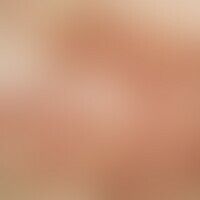
Lymphangioma circumscriptum D18.1

Primary cutaneous follicular lymphoma C82.6
Primary cutaneous follicular center lymphoma: chronically active, increasing for 12 months, localized on the trunk and upper extremities, disseminated, 0.3-0.7 cm in size, asymptomatic, hemispherical, firm, smooth, red papules and nodes.
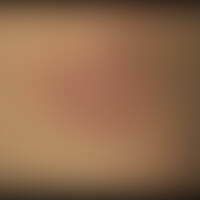
Herpes simplex recidivans B00.8
Herpes simplex recidivans: recurrent, in this case very extensive, multilocular herpes simplex infection in an HIV-infected person at intervals of 6-8 months

Komedo L73.8
Comedo (giant comedo): approx. 2.0 cm large, firm knot with a black, keratotic centre about 0.3 cm in size.
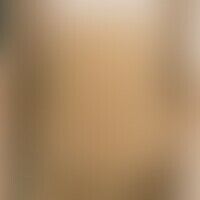
Erythrokeratodermia progressive symmetrica Q82.8
Erythrokeratodermia progressiva symmetrica. extensive, sharply defined, brown-yellow discoloured, scaly and hardened plaques existing since the 2nd LJ, which had already appeared on other parts of the trunk, but healed there in the meantime. occasional slight itching.

Lichen planus classic type L43.-
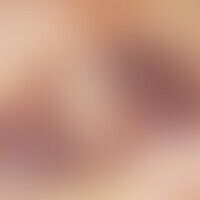
Ecchymosis syndrome, painful R23.8
ecchymosis syndrome, painful, intermittent manifestation of painful skin bleeding in a 48-year-old man. initial development of oedematous, overheated, pressure-sensitive erythema. subsequent development of skin bleeding and slow expansion of the skin changes. scarless healing after 1-2 weeks. in the present case, there was a severely pronounced clinical picture with multiple accompanying symptoms, especially fever, weight loss, fatigue, muscle and headaches, arthralgia, epistaxis, haemoptysis and haematuria.
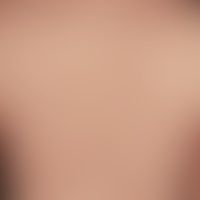
Dermatitis herpetiformis L13.0
Dermatitis herpetiformis: chronically recurrent course of the disease. persists for about 3 years. disseminated, burning, partly also stinging urticarial papules, papulo vesicles and erosions.
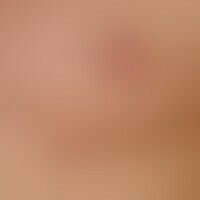
Nipple accessory Q83.3
Mammilla, accessory. 0.6 cm high, solitary, brown plaque, clearly grown during puberty, localized in the so-called embryonic lactiferous ridge, without symptoms, with a central pointed conical papule and a coarse-fielded surface.

Sweet syndrome L98.2
Dermatosis, acute febrile neutrophils (Sweet Syndrome): suddenly appearing inflammatory, succulent, livid red papules that have conflued into larger and plaques, combined with fever and feeling of illness.

Nevus melanocytic halo-nevus D22.L
Nevus, melanocytic, halo-nevus. solitary, depigmented, oval, sharply defined, smooth, white patch with central, sharply defined, brown, slightly raised papule. 27-year-old patient with multiple halo-nevi is shown here.

Circumscribed scleroderma L94.0
scleroderma circumscripts (linear type): band-shaped expression of the scleroderma focus on the upper and lower leg. in the thigh area, clear atrophy of skin, subcutaneous fatty tissue (and muscles). clinical picture developed over a period of about 7 years. pulling and stabbing complaints during sports activities.

Naevus melanocytic common D22.-
Nevus melanocytic more common: dermal n evoid melanocytes with monomorphic nucleus and only a few single nucleoli in here neuroid cytomorphological features with a wider pale eosinophilic cytoplasmic border

Sarcoidosis of the skin D86.3
Sarcoidosis plaque form: 1-year-old disseminated scaly papules and plaques of varying sizes.

Keloid (overview) L91.0
Keloids. since puberty known now healed acne vulgaris. for months development of these papular or nodular elevations of the skin.

Pityriasis rosea L42
Pityriasis rosea: Collerette scaling: For Pityriasis rosea pathognomonic form of scaling with exactly one ring of fine, slightly raised, whitish scaling about 1-2mm indented from the lateral edge of the reddish plaque.
Note: this form of "keratolytic" desquamation results from the repulsion of superficial, parakeratotic horn lamellae.

Atrophy of the skin (overview)
Atrophy of the skin: age-related flabby atrophy of the dorsal skin with partly swirled, partly parallel, vertical wrinkles; no significant light aging

